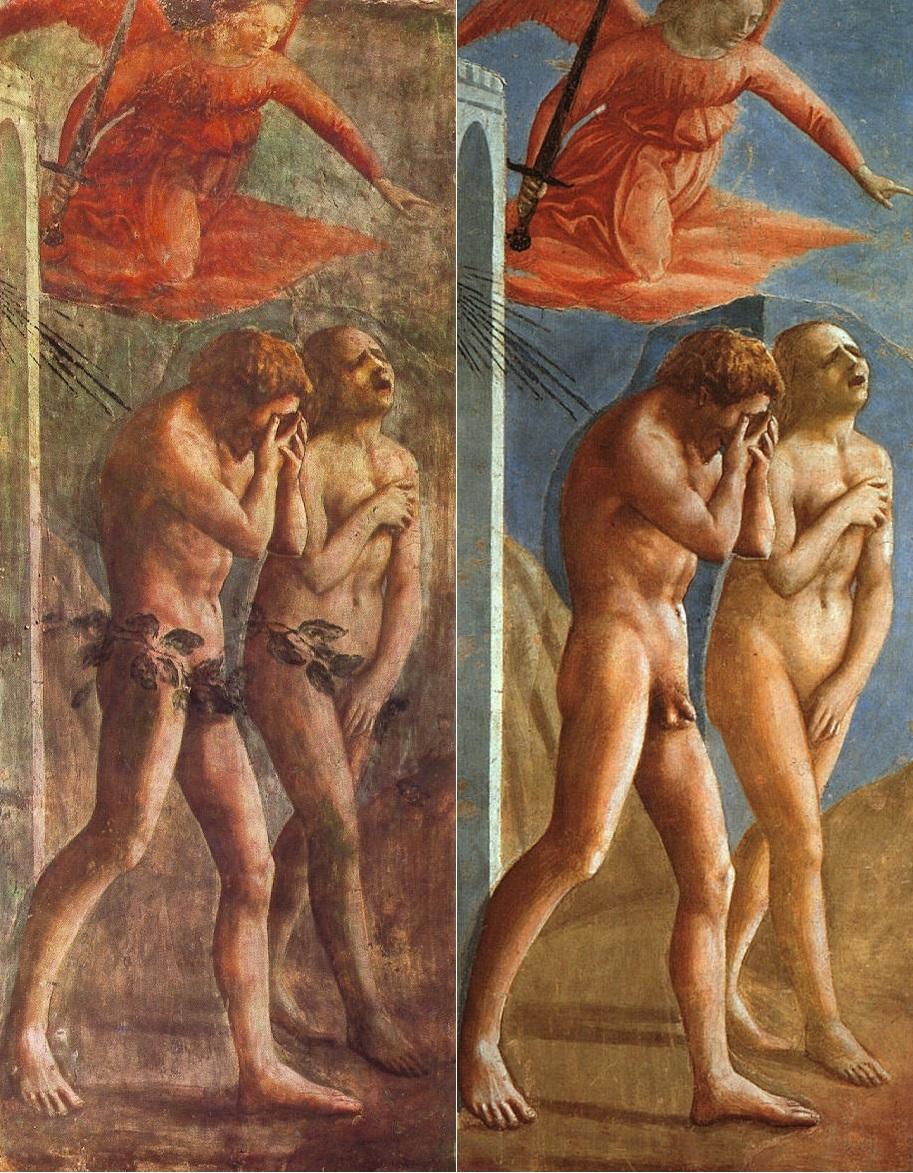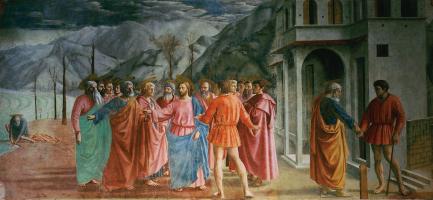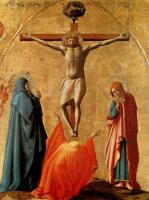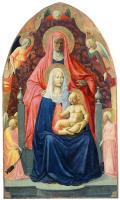Masaccio
The tragically short-lived Masaccio (Tommaso di Ser Giovanni di Mone) was the first great Florentine painter of the Italian Renaissance. He created dramatic effects by his use of space, light and perspective; and in the twenty-seven years of his life he developed an austere realism and economy of style which influenced many other artists.
 The Rendering of the Tribute Money describes a scene from Matthew’s gospel.
The tax collector at the Capernaun demands payment of the temple tax. Jesus’
answer is to order Peter to catch a fish, and in its mouth they will find a
miraculous silver coin. Historians believe this painting alludes to a
controversial tax reform in Florence. Masaccio may have included himself in
the group of apostles, possibly as St. Thomas, on the right. The apostles
stand in a distinct semi-circle, solidly modeled in their Greek-style tunics
and cloaks. The landscape in the background is painted in perfect perspective
with successive planes of distance and the light very clearly coming from one
source.
The Rendering of the Tribute Money describes a scene from Matthew’s gospel.
The tax collector at the Capernaun demands payment of the temple tax. Jesus’
answer is to order Peter to catch a fish, and in its mouth they will find a
miraculous silver coin. Historians believe this painting alludes to a
controversial tax reform in Florence. Masaccio may have included himself in
the group of apostles, possibly as St. Thomas, on the right. The apostles
stand in a distinct semi-circle, solidly modeled in their Greek-style tunics
and cloaks. The landscape in the background is painted in perfect perspective
with successive planes of distance and the light very clearly coming from one
source.
Masaccio was responsible for several of the frescoes in the Brancacci Chapel in Florence. One of these, The Expulsion, shows the figures of Adam and Eve as they leave the Garden of Eden after their banishment. There seems to be a physical force behind them, driving them through the gates of Paradise; and over their heads an angel flourishes a sword, both to urge them on and to guard the gates of the Garden. The angel is amply clothed in flame-coloured draperies, accentuating the vulnerable state of the figures of Adam and Eve, naked but for a garland of leaves. Eve’s hands, one covering her groin, the other her breasts, are in the traditional pose of female nudes derived from classical statues of Venus.
 Her mouth is open in a scream of anguish; perhaps she already anticipates the
pain she must soon suffer in childbirth, now that the gift of immortality has
been taken away from them. Adam holds his hands to his eyes, his shoulders
bowed and his whole attitude expressing his despair.
Her mouth is open in a scream of anguish; perhaps she already anticipates the
pain she must soon suffer in childbirth, now that the gift of immortality has
been taken away from them. Adam holds his hands to his eyes, his shoulders
bowed and his whole attitude expressing his despair.
The figures are real, and not idealized in any way. They are made of flesh and blood, substantial and entirely three-dimensional. Adam’s feet are placed firmly on the ground, and they are bearing his weight. Light falls on the scene in a natural manner, and shadows define the shapes of the human figures. As a result of accurate observation and scientific study, Masaccio was able to convey human emotion in an astonishingly convincing manner, and he reveals the agonizing plight of Adam and Eve in a painting of powerful simplicity.
Three centuries after the fresco was painted, Cosimo III de’ Medici, in line with contemporary ideas of decorum, ordered that fig leaves be added to conceal the genitals of the figures. These were eventually removed in the 1980s when the painting was fully restored and cleaned.
 This group was a collaboration between Masaccio and Masolino. The composition
of the major figures shows that they were Masaccio’s contribution. The
Madonna’s right knee presses forward through the fabric of her dress and the
hand of St. Anne seems to explore the depth of the picture-space. By contrast,
Masolino’s angels remain rather flat and pale, with scarcely enough strength in
their slender hands to hold the curtain up at the back.
This group was a collaboration between Masaccio and Masolino. The composition
of the major figures shows that they were Masaccio’s contribution. The
Madonna’s right knee presses forward through the fabric of her dress and the
hand of St. Anne seems to explore the depth of the picture-space. By contrast,
Masolino’s angels remain rather flat and pale, with scarcely enough strength in
their slender hands to hold the curtain up at the back.





